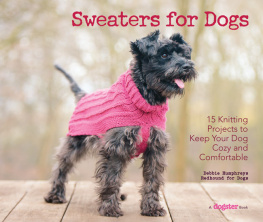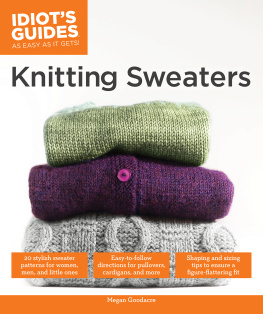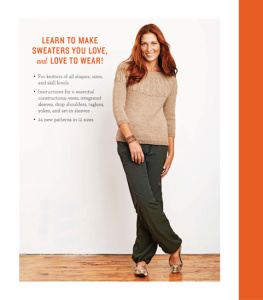I WROTE THIS book because Im a plus-size knitter, and I know some things about sweater construction. In these pages, I intend to give you the tools and information you need to knit sweaters that fit you, that achieve your knitting objectives, and that are fun to make. This is a book about knittingnot about fashion, self-confidence, or what not to wear. Whether you are new to making sweaters or just want to advance your understanding of the mechanics, Knitting Plus will give you the rules of sweater construction and insight into what those rules mean for the plus-size. And there are some lovely patterns, too.
Working on the editorial staff of Interweave Knits and Knitscene magazines, my primary job has been manager of knitting patterns. In this job, I have studied many sweaters and learned many ways to construct a garment. In the end, most sweaters fall into five basic styles:
+ drop shoulder (including modified drop shoulder)
+ set-in sleeve
+ raglan yoke
+ seamless round yoke
+ dolman (which encompasses a lot of variations)
These construction styles all pivot around armhole and sleeve cap design. The body of a sweater can be shaped a myriad of ways, but the treatment of the sleeve-to-body join makes all the difference in fit, style, and final product. Sweaters in these styles usually follow general ruleslearning these rules can help you throughout your knitting endeavors. This book will particularly focus on these five styles and what they can do for the plus-size wearer.
Knitting Plus is divided into seven chapters. covers taking measurements, choosing a size to knit, and tips on customizing patterns to fit your particular shape. The basic sweater styles are presented in the remaining five chapters. Within each of these chapters, I provide a basic sweater pattern in the relevant construction stylea design worked in stockinette without much adornment to illustrate the basic look and elements of that style. These basic designs are easy to customize for individual shape and can be considered a kind of template for plus-size sweaters. The basic sweater is followed by more involved designs that showcase the possibilities of the constructions. Although this book offers very detailed information about adjusting patterns, you should not feel daunted; not every plus-size woman will require this level of modification. And even those who do can begin with some of the simpler adjustments.
The information in this book will advance your knitting knowledge and your understanding of sweater making. It will give you valuable insight to make better sweaters that fit your own personal shape. I hope the collection of patterns will inspire you to start knitting now.


THIS CHAPTER explains the standard elements of a sweater, how they interact with each other, and the implications thereof for plus-size women.
We measure the bust circumference of a sweater just below the underarm. The sweater circumference below the underarm must be wide enough to accommodate the fullest part of the bust. In a sweater with hourglass shaping, the bust shaping reaches its full width below the armholes. For designs with body shaping, plus-size and/ or busty women should have the widest bust circumference extend to about 5" (12.5 cm) below the underarm.
Most womens knitting patterns are sized by the bust circumference. The other measurements, such as cross-back width, shoulder width, upper arm circumference, and so on, relate to the bust circumference and are based on standards such as those provided by the Craft Yarn Council of America (CYCA; see ).













